4.1.2 - What needs to be considered in the design stage?
Return to Main Menu | Return to Step 4 | Return to Step 4.1 | Next Step
The design issues focus on the following sub-questions:
4.1.2.1 - Do I have a Whole Farm Plan?
4.1.2.2 - What slope, length and width should my bays have?
4.1.2.3 - What should be the size of my channels and drains?
4.1.2.4 - How big should my drainage reuse system be?
4.1.2.1 - Do I have a Whole Farm Plan?
| To discuss your Whole Farm Plan contact DEPI Tatura reception on 03 5833 5222. Preparing a Whole Farm Plan (WFP) is the fundamental first step in developing an irrigation system. It is particularly important for border-check irrigation as it integrates all farm development components, including :
A good WFP ensures that maximum productivity is obtained from the resources available. |
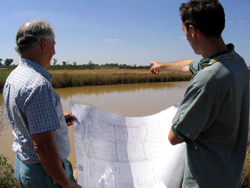 A whole farm plan is essential |
4.1.2.2 - What slope, length and width should my bays have?
Designing border-check irrigation bays for optimum efficiency and productivity is a complex process, involving a number of inter-related factors:
In addition, the bay designs have to be integrated into the Whole Farm Plan to achieve the optimum overall operation of bays, channels and drains, drainage reuse, laneways and grazing management. |
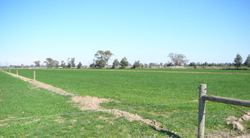 The design of the bays is important for efficient irrigation |
For more detailed information on designing irrigation bays, see Step 4.1.2.3 or the DPI Agnote “Border-check Irrigation Design” (external link) and the DPI publication “Irrigation system selection and design for northern Victoria: Volume 3: Design, implementation and operation considerations for border-check irrigation layouts”
For information on the design of farm channels, see “Farm Channels for Border Check Irrigation” (PDF 1.5MB), Rural Water Commission of Victoria (now Goulburn-Murray Water).
For information on the overall layout of bays channels and drains, laneways and grazing areas, see ”Designing Paddocks on an Irrigated Dairy Farm” (PDF 731KB), Rural Water Commission of Victoria (now Goulburn-Murray Water) (external link).
Computer models which simulate the border-check irrigation process can help in the design of optimum bay dimensions and slope. One such model is the Analytical Irrigation Model (AIM), developed at DPI Tatura particularly for the soils typical of the SIR. A description of the model and its use is given in “Irrigation system selection and design for northern Victoria: Volume 3: Design, implementation and operation considerations for border-check irrigation layouts”. For more information about the AIM model, contact DPI Tatura
To view the information PDF requires the use of a PDF reader. This can be installed for free from the Adobe website (external link).
4.1.2.3 - What should be the size of my channels and drains?
| Properly designed farm channels and drains are important for the operation of border-check systems to get water onto the bays at the desired flow rate, and to get drainage off the bays in a reasonable time. This is particularly important in the SIR where the landscape is relatively flat, often resulting in limited head (or elevation) availability to ensure good flows. Channels – In the SIR, water is commonly supplied to the farm by gravity from the Goulburn-Murray Water channel system, usually through a through an electromagnetic, or magflow, meter.In some cases where head in the supply system is insufficient to supply water by gravity, pumping will be necessary. For more information on farm channels see “Farm Channels for Border Check Irrigation” (Rural Water Commission of Victoria 1991 - now Goulburn-Murray Water), and the DPI “Target 10 (external link) Irrigation and Drainage Reference Manual” (Mulcahy and Schroen, 1993) (external link). | 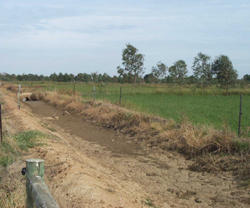 The farm channel and structures must be designed to suit the system |
To view the information PDF above, requires the use of a PDF reader. This can be installed for free from the Adobe website (external link).
| Pipe and risers – The farm channel system can be replaced by pipes, with water being piped to individual bays. This usually requires the installation of a pump. This system offers considerable advantages: - land otherwise occupied by channels can be used productively; - access is not restricted by channels; - bays can be irrigated in any sequence; - there are no seepage and evaporation losses; - there is no channel maintenance such as weed control; and - channels don’t have to be filled and drained. Pipe and riser systems have to be properly designed to match pumps, flow rates and pipe diameters. Local suppliers are able to give advice. The disadvantages of pipe and risers are mainly the substantial capital installation costs and the ongoing pumping costs. | 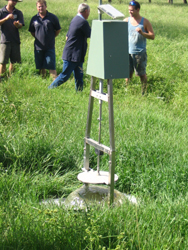 An automated pipe and riser outlet |
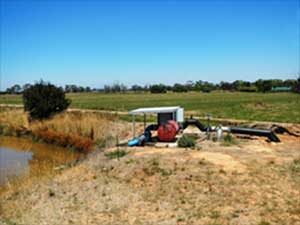 | 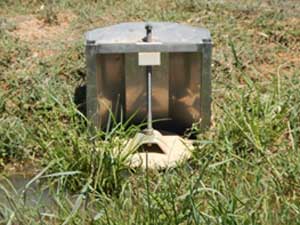 |
Drains and drainage reuse – Good drainage and a reuse system are essential for the efficient operation of border-check systems. Information on farm drains and drainage reuse systems is presented in the DPI “Target 10" Irrigation and Drainage Reference Manual” (Mulcahy and Schroen, 1993) (external link).
4.1.2.4 - How big should my drainage reuse system be?
Adoption of higher inflow rates can increase volumes of runoff, and inadequate or poorly maintained drains can increase the duration of ponding on bays. Surface drainage systems must have sufficient capacity to accommodate irrigation runoff, particularly on farms using higher inflow rates.
| The recommended drainage reuse storage capacity is 0.75 ML per 10 ha of perennial pasture (15% of an average irrigation application). A practical consideration is to make the drainage reuse storage large enough to provide at least the amount of earth needed for channel and laneway pads. Financial assistance is available in the SIR for the installation of drainage reuse systems. For more information, contact your local DPI office. Note that the maximum capacity for new storages, as determined by the farm dams legislation, is 1 ML per 10 ML of irrigated land. See Step 2.2.11.5 - Irrigation Farm Dams. |
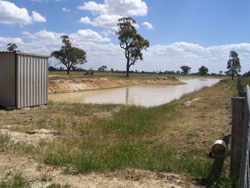 The drainage reuse sump must be well located and well designed |


